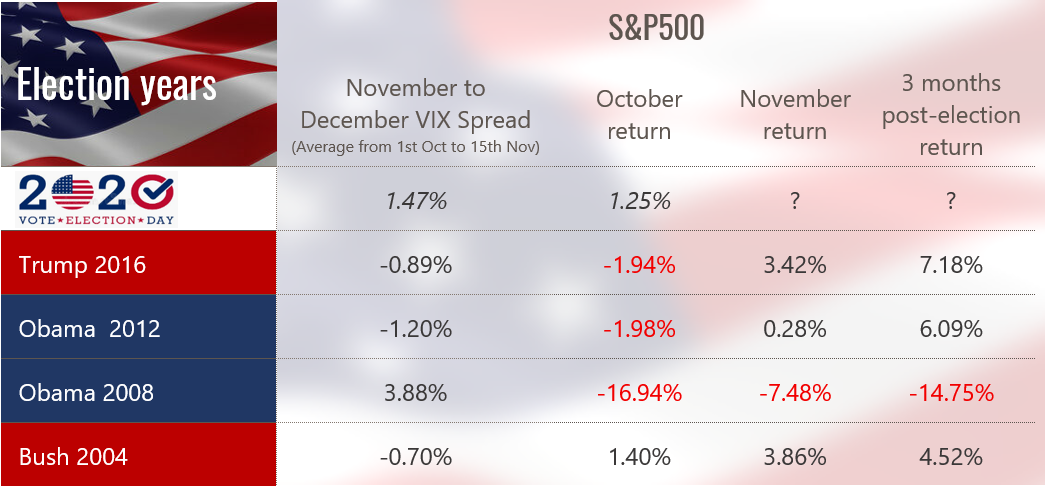09.10.2020
US-Wahlen: Welche Risiken sind bereits eingepreist?

There is no doubt that a US presidential election represents a risk for financial markets and a good way to quantify how much risk is currently priced-in is to look at the forward implied volatility before and after the elections.
For that, the VIX index, a basket of the S&P 500 options volatility, sounds a good barometer.
Looking at the VIX curve, The November expiry is currently trading 1.5% above the December one, reflecting the immediate risk investors are facing post-election (November 3rd) relative to December.
While the 1.5% spread indicates a higher implied risk around and after the election, it does not quantify the absolute level of risk. To put it in perspective, we looked at the average November-December VIX Spread from October 1st to November 15th for every US Election since 2004.
Excluding the US election during the Great Financial Crisis in 2008 where spot volatility was structurally higher than 1, 2 and 3 months forward, it appears that a positive November/December VIX Spread is somewhat unusual. In fact, during the 2004, 2012 and 2016 elections, the November VIX never traded above the December one.
Looking at the return of the S&P in October, November and 3 months after the election, we can observe that it is very difficult to draw any conclusion over a US presidential election from a financial market perspective. If anything and excluding the 2008 election during the crisis, the simple and most direct conclusion would be that a US presidential election after 2000 had a positive impact on the S&P 500 Index one month and 3 months after the outcome.
So how to explain this extra-risk this time? We believe the 1.5% premium in November volatility relative to December likely reflects one single risk: if Biden wins, President Trump might not going to accept it. A sentiment that has been reinforced after the first TV debate of the US elections.
To conclude, history shows that financial markets can easily deal with a republican or democrat president but definitely not with no President after November 4th.
Mehr Publikationen
01.12.2025
Ein Rückblick auf unser Event im Auktionshaus Koller!
Entdecken Sie die Highlights und Fotos dieses denkwürdigen Events!
Mehr dazu26.11.2025
Die industrielle Ordnung der letzten 30 Jahre ist gerade still und leise zerbrochen.
2025 markiert einen historischen Wendepunkt: Deutschland, einst das industrielle Kraftzentrum der Welt, importiert nun mehr Investitionsgüter aus China als es exportiert. Eine symbolische Umkehr, die Europa dazu zwingt, seine technologische Souveränität und Industriestrategie neu zu überdenken.
Mehr dazu14.11.2025
Rückblick auf unser exklusives Event mit Alexandra Kosteniuk, Schach-Großmeisterin
Werfen Sie einen Blick auf die Höhepunkte und Fotos dieses unvergesslichen Events!
Mehr dazu11.11.2025
Märkte basieren nicht auf Hype — sie basieren auf Gewinnen.
Jeder Marktzyklus hat seine eigene Geschichte. Gestern waren es Nullzinsen und Stimulus. Heute ist es künstliche Intelligenz. Morgen wird es etwas anderes sein. Doch unter all dem Lärm bleibt eine Wahrheit bestehen: Gewinne bewegen die Märkte.
Mehr dazu31.10.2025
2. Jahrestag unseres Swiss Real Estate Basket
Wir freuen uns, mit Ihnen den zweiten Jahrestag unseres Swiss Real Estate Basket zu feiern, der in Partnerschaft mit IMvestir Partners SA in steuereffiziente und börsennotierte Fonds investiert.
Wir freuen uns, Ihnen eine kontinuierliche Wachstum melden zu können, und möchten unseren Anlegern für ihre anhaltende Vertrauen danken.
Mehr dazu28.10.2025
“Preemptive cut” : der erste entscheidende Schritt des nächsten US-Wirtschaftszyklus
Wenige Tage vor einer entscheidenden Sitzung der US-Notenbank Federal Reserve erläutert John Plassard, Partner und Leiter der Anlagestrategie bei Cité Gestion, in einem Video ein Konzept, das mittlerweile eine zentrale Rolle in der amerikanischen Geldpolitik spielt: den „preemptive cut”.
Mehr dazu